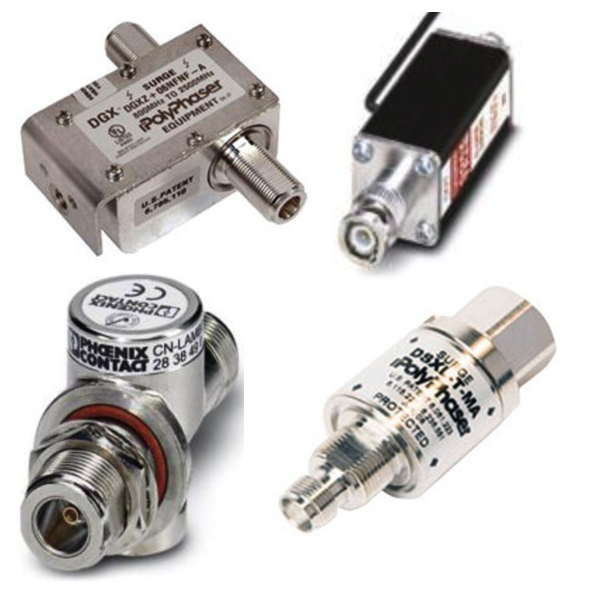RF Surge Protectors

Lightening and power surges are the biggest threat to communication equipment like radio and TV antennas. Without the proper protection, a single lightening strike can travel through the coaxial cable, damage connected devices and possibly cause a fire or electric shock to surrounding people. Static charge build up and near miss lightening strikes can also create power surges and damage equipment. Installing an in-line surge protector in the path from the antenna to the signal booster disconnects the circuit in the event of a power surge.
RF surge protectors (lightning surge arrestors, lightning surge protectors or surge suppressors) are designed to protect radio and antenna installations from a power surge caused by lightning while still allowing the desired frequency to pass through the cable. Some RF surge protectors also provide protection from electromagnetic pulse or high-altitude electromagnetic pulse related electrical changes.
More Information about RF Surge Protectors
A coaxial RF surge protector is composed of a gas discharge tube (GDT) housed between coaxial terminals and connectors. This allows it to be mounted at the coaxial entry point of a radio site or at the base of an antenna. Grounding is provided by using a screw terminal. When a power surge occurs, the GDT shorts the line, diverting the surge through the GDT to ground.
Grounding vs. Surge Protection Grounding is the first step in lightening protection. Antennas should be ground bonded to the tower they are on and the tower should be bonded to a ground rod buried at the base of the tower. When a lightening strike occurs, the surge will travel into the ground. The lightening will also follow the coax cable into the connected devices. Surge protection devices can be installed in-line of the coax to break the connection when a sudden surge travels across them protecting the connected devices and equipment.
FAQs
Do coax surge protectors protect active antenna systems from indirect lightning strikes?
Yes, coaxial surge protectors are designed to protect active antenna systems, including coaxial cables and related equipment, from indirect lightning strikes and other electrical surges. Coaxial surge protectors are commonly used in a variety of applications, including telecommunications, radio and television broadcasting, and wireless networks.
Do coaxial RF surge protectors provide multi strike capability?
Yes, coaxial RF surge protectors are designed to provide multi-strike capability. They are designed to divert transient voltages away from the equipment they are connected to, and then return to their normal state after the surge has passed. This means that they can protect against multiple surges over time without needing to be replaced.
Does suppressing DC surge protect sensitive equipment from strong electrical events?
Yes, suppressing DC surge helps protect sensitive equipment from strong electrical events by diverting harmful voltage spikes away from critical components and maintaining system stability.
Coax Lightning Protection Basics
4 things to consider when selecting lightning protection for coax connected devices:
Frequency range
All lightning protectors offer a specific frequency range that they protect against. For example, a protector may offer 698 megahertz all the way up to 2.7 gigahertz of protection.
Connection type
The most common connector is N female, however, there are also N male, TNC or many other different types of connections. In some cases the protector offers bidirectional protection so the input and output can be reversed.
DC pass vs DC block type protectors
DC pass type protectors are used if power is needed at the antenna tower to power a particular device. It allows low voltage current to pass through the center pin of the coax cable to power the device. If no power is needed at the antenna tower, a DC block type protector is used, which would not allow any current to pass through the center pin of a coax connector.
Technology type
The most common and cost effective type of technology is gas tube protection. In most cases, it will last about five years. One thing to consider with gas tube protectors is that they can build up static electricity over time, and if that static electricity discharges, it can damage equipment. The second type of technology is coil inductors. Coil inductors offer very reliable protection against lightning strikes and heavy surges, as well as not degrading over time. They only need replacement with significant lightning strikes. There is no threat of static buildup with a coil inductor protector. The only real disadvantage of using coil inductor technology is the cost. Typically, they are about 30 to 40% more expensive than gas tube technology.

